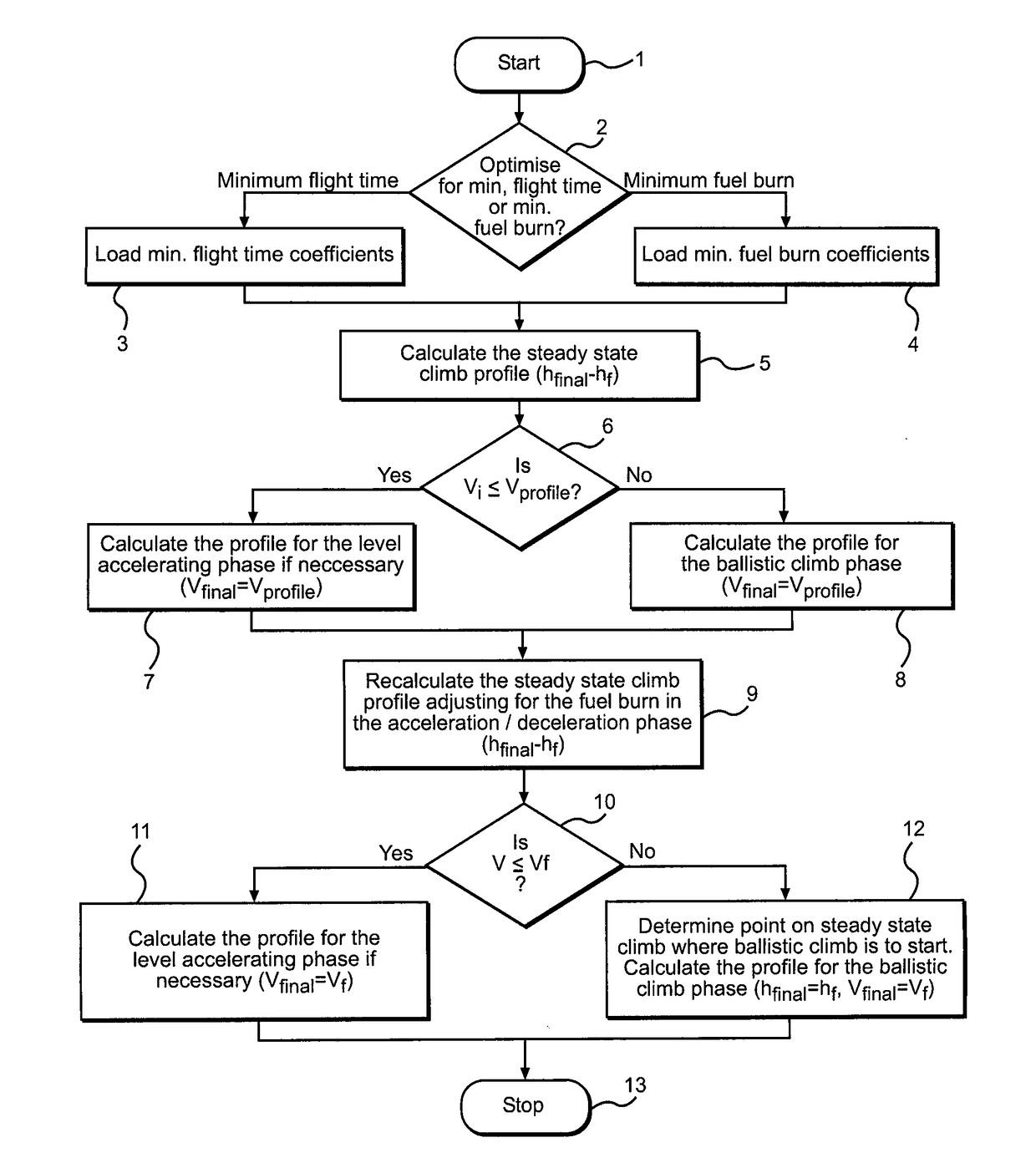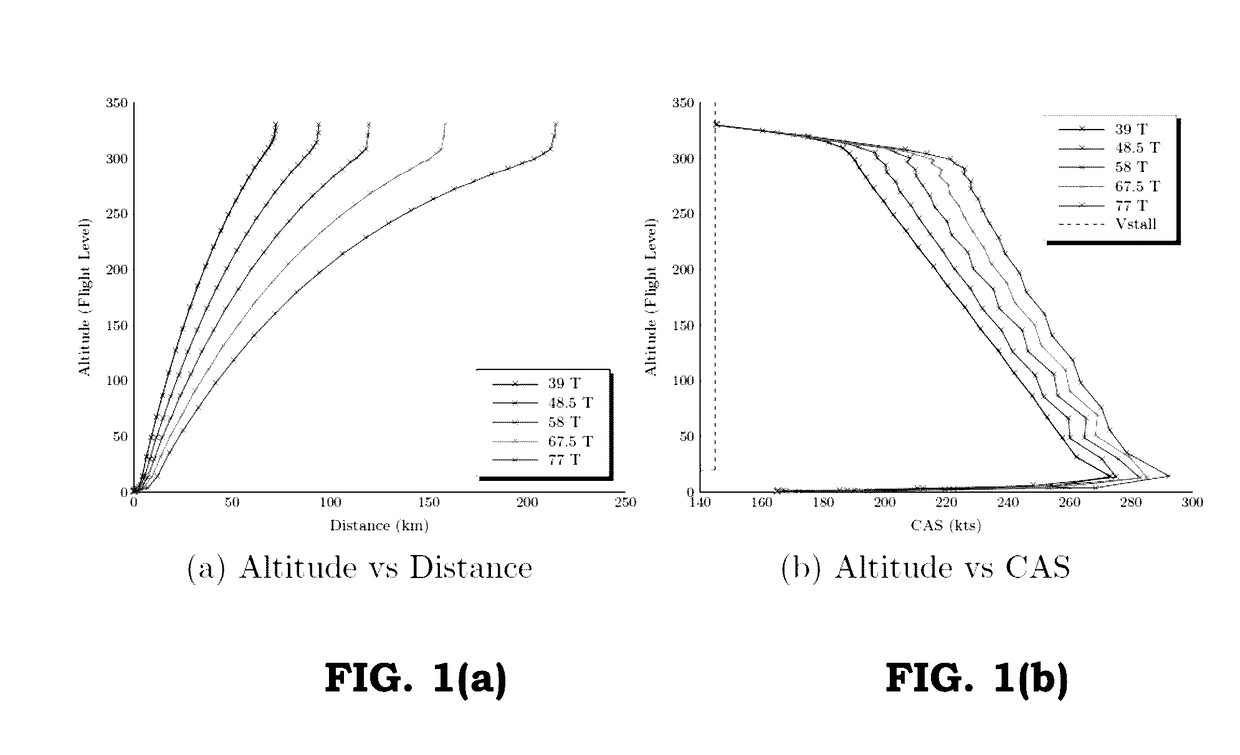Fast flight trajectory optimisation for in-flight computation and flight management systems
a flight trajectory and computation technology, applied in the field of fast flight trajectory optimisation for in-flight computation and flight management systems, can solve the problems of unsatisfactory current operating practices, and achieve the effect of better selection of flight operating points
- Summary
- Abstract
- Description
- Claims
- Application Information
AI Technical Summary
Benefits of technology
Problems solved by technology
Method used
Image
Examples
example 1
Operating Intention—Climb to Altitude
[0056]In the Climb to Altitude example, the objective is that of flying from the initial to the final altitude for minimum flight time or minimum fuel burn (or a combination of both) in the most advantageous manner irrespective of the eventual distance to be flown. The optimization function (algorithm) requires, as parameters or inputs, the initial states xi (horizontal position), hi (altitude), Vi (true airspeed) and mi (aircraft mass), final states hf and Vf and T (temperature at MSL).
[0057]When climbing in an optimal manner for any combination of the two said objectives (that is, at any point on the Pareto frontier), the aircraft flies a sequence of three flight segments. In essence, the sequence involves a steady state climb profile with initial and final segments involving accelerations or decelerations to allow for adjustment of airspeed at the start and end of the steady state climb segment.
example 2
Operating Intention—Climb to a 3D Point in Space
[0065]In the Climb to a 3D point in space, the objective is that of flying from an initial (first) to a final (second) point in space.
[0066]It is known that most minimum flight time trajectories adopt a non-steady climb with a segment of flight at the crossover altitude, while in other circumstances steady climbs may be adopted. In the case of minimum fuel burn trajectories, the climb is always continuous to the final altitude. Consequently, minimum flight time and minimum fuel burn trajectories are treated independently in two separate algorithms.
[0067]A—Optimisation for Minimum Flight Time
[0068]The flowchart of the algorithm for minimum flight time is presented in FIG. 6. On start-up (step 101), the algorithm calculates a first profile for the aircraft to accelerate to maximum speed (step 102) and then, in step 103, calculates a profile for steady-state climb at maximum speed to the final target altitude. If the distance covered is l...
embodiment 3
Climb to a 3D Point in Space in a Fixed (Pre-Specified) Time
[0078]The Climb to a 3D point in space in a fixed time extends Example 2, (Climb to a 3D point in space) to also include a fixed flight time, which often relates to a target time of arrival (known as TTA, which herein is the same as the required time of arrival, or RTA). In this context, it is of value to fly the most economical trajectory in the corresponding flight time once a TTA is assigned.
[0079]Mathematically, optimising the trajectory against two objectives, such as minimum flight time and minimum fuel burn, gives rise to a Pareto frontier of optimal solutions, as that shown in FIG. 2. Each one of these solutions corresponds to the speed-altitude schedule that consumes the least fuel burn for a given flight time. The algorithm described herein generates trajectories corresponding to individual points on the said Pareto frontier.
[0080]The diagram in FIG. 8(a) presents speed-altitude schedules of a generic set of Paret...
PUM
 Login to View More
Login to View More Abstract
Description
Claims
Application Information
 Login to View More
Login to View More - R&D
- Intellectual Property
- Life Sciences
- Materials
- Tech Scout
- Unparalleled Data Quality
- Higher Quality Content
- 60% Fewer Hallucinations
Browse by: Latest US Patents, China's latest patents, Technical Efficacy Thesaurus, Application Domain, Technology Topic, Popular Technical Reports.
© 2025 PatSnap. All rights reserved.Legal|Privacy policy|Modern Slavery Act Transparency Statement|Sitemap|About US| Contact US: help@patsnap.com



